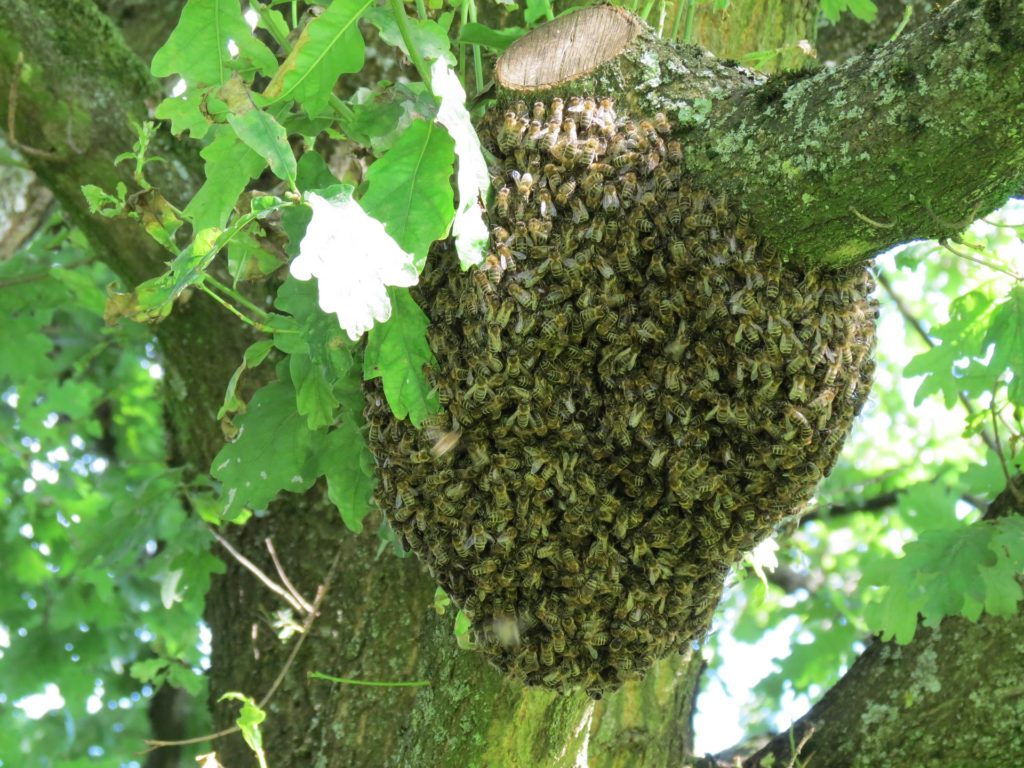It’s Swarm Season!
It’s a common sight all across Australia as soon as sunny spring weather hits – bee swarms. A buzzing, brown cloud of wayward honey bees moving en masse, clinging to each other. Then they settle on whatever temporary foothold they can find while the scout bees search for a new home.
Beekeeping groups online are also buzzing – with calls and offers to collect and re-home swarms. The enthusiasm of home and business owners to get rid of these wayward bees is only surpassed by the enthusiasm of the beekeepers! After all, collecting bee swarms is a great way of getting new stock to expand your apiary.
What Exactly is a Bee Swarm?
The Australian Beekeeping Guide describes a bee swarm as ‘the way bee colonies reproduce’. By ‘reproduce’ it actually means that the colony duplicates itself, through splitting in half. Usually, it is the old queen who leaves the hive with around half her workers.
The swarm doesn’t travel far at first, usually forming a temporary cluster on a structure up to 200 metres from the parent hive. A swarm will gather on anything, from shrubs and tree branches to man-made structures including buildings. This is their temporary home while scout bees search for a permanent hive location.
The first swarm is called the ‘prime’ swarm. Occasionally, smaller ‘after swarms’ may leave several days later, as young queens emerge.
Soon after swarming, a new virgin queen will emerge from her cell in the parent hive. She kills any younger rivals still in their queen cells then leaves the hive to take orientation flights. Mating flights then follow. Some days later she begins egg-laying as the new queen of that hive.
When do bees swarm?
The impulse to swarm is strongest in spring and early summer. It can be stronger in some years than in others due to many factors. According to the Australian Beekeeping Guide, few swarms occur after the summer solstice (the longest day of the year).
Swarms usually leave the hive on sunny mornings after the first queen cells are sealed. Swarming is often delayed by bad weather.
Yet, the impulse to swarm may be so strong that it can depart in any weather, leaving very young queen cells or even just eggs in cell cups. As it turns out, there are many factors that influence swarming behaviour.
What Causes Bee Swarms?
Congestion
Many things cause a colony to swarm, but a major factor is congestion (too many bees/not enough space) in the hive. Managed colonies in single box hives and nucleus boxes will swarm when they run out of room.
According to the NSW Department of Primary Industries, congestion may reduce the queen pheromone available to each worker bee. A reduction in pheromone stimulates workers to begin constructing queen cells.
Queen Bees
Colonies with old queens are also more likely to swarm because she produces less pheromones as she ages.
But some colonies under identical conditions will be more inclined to swarm than others. This is due to genetics. The genetic variation between honey bees is wide, and the genetics of a hive is greatly determined by the queen. This is likely to have greater influence on swarming behaviour than her age.
Warmer Weather
Warmer weather after the winter period is also known to play a role in stimulating a colony to swarm.
Nectar and pollen flows
Colonies are more likely to swarm when they are on ‘build-up flora’, which provides light nectar flow and heavy pollen supply.
This is because build-up flora in early spring usually leads to rapid expansion of the brood nest. The colony can grow too fast, resulting in idle worker bees and congestion.
Bees are less likely to swarm when they have access to an ample nectar flow and are storing honey. These conditions help keep the workers busy and support the increased population.
Flora Types
According to the Australian Beekeeping Guide, in some years, bees are more inclined to swarm when foraging on certain flora. Some plants known to have this effect are lupins, cape weed and especially canola.
Why is Swarming a Problem?
Swarming results in a major loss of adult bees. It also causes a break in the brood rearing cycle (until the new queen begins to lay) at the most important time of year to strengthen a colony.
Swarming can leave colonies too weak for good honey production and pollination, for half the season. When there are both prime and after swarms, colonies may become so low on adult bees that they die off.
Some Australian states also have codes of practice that requires beekeepers to prevent swarming. If a swarm leaves an apiary, the beekeeper should collect it as soon as possible to prevent it troubling neighbours or members of the public. Our next post will look at swarm prevention and management, a key part of responsible beekeeping.
For swarm collection services, supplies and advice give Ian a call on 0437 902 749 or email [email protected]

Visit the Bee2Bee online shop for beekeeping equipment and supplies.




